Continuous Motion Offense Screen Away Continuity
Basketball Offense - Bob Hurley: Motion Offense
By Dr. James Gels, from the Coach's Clipboard Basketball Playbook
Disclosure: This page contains affiliate links, which means that Coach's Clipboard receives a small commission (at no cost to you) if you make a purchase using these links.
Legendary high school boys coach Bob Hurley has coached for over 40 years at St. Anthony High School in Jersey City, New Jersey. His teams have won 25 state championships and over 1000 games. Hurley was inducted in the Basketball Hall of Fame in 2010. His son Bobby was an All-American guard at Duke.
His DVD "Bob Hurley: Motion Offense" outlines his successful offensive scheme. Hurley discusses how to build a motion offense using several formations - box, double stack low, hi-lo, and high. He also presents six "audibles" that can be run with any of the sets. He also discusses transition offense, the 4-out Wheel set, and how to attack zone defenses. Price: $39.99 (more info).
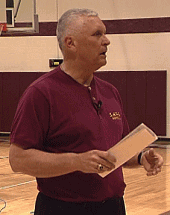
Why Motion Offense?
Motion offense is a free lance offense that is unscripted, although many coaches start in a certain set and run several options or actions ("audibles"). Players read the defense and react accordingly. Coach Hurley reviews some of the advantages of motion offense:
- Freedom of movement.
- Fit to your personnel (4-out, 3-out, 5-out).
- Can use various sets, changing the "look".
- Difficult to scout.
- Equal opportunity offense - although you can use quick hitters to get shots for your best shooters.
- Teaches players how to play, not just run patterns.
- Flexible - can use various startup sets, audibles, and quick hitters.
- Roles - you can define who are your shooters, and your screeners (like in Dick Bennett's Blocker Mover offense).
Audibles
Several audibles can be called to start the action for any of the formations (sets) described below.
"Shallow"
Using the "shallow" audible, O1 dribbles to the wing (diagram 3), and O2 curls around O5 and cuts to the top. O1 might pass to O5 in the post, or to O2 at the top.
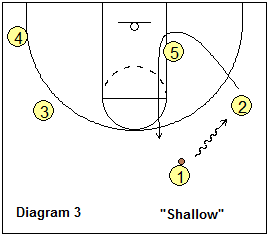
"Circle"
O1 again dribbles to the right wing. O2 cuts around screens from O5 and O4 (diagram 4). O3 "circles" (rotates) up to the top. O1 reverses the ball to O3 (diagram 5), and O3 passes to O2 for a possible shot. O2 might also pass to O4 in the low post, or to O5 flashing to the ball-side elbow. Optionally, instead of O4 screening for O2, O2 back-screens for O4 (diagram 6) on the initial circle cut, and O3 looks to pass to O4 on the basket-cut.
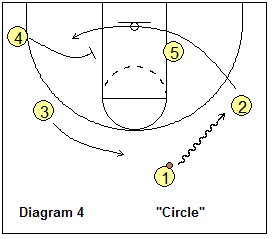
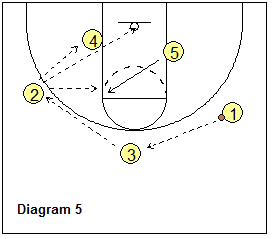
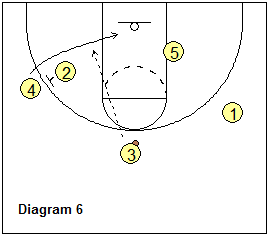
"Cross"
With cross, O2 and O3 cross underneath (diagram 7), with O2 first screening for O3. After O2 and O3 cut, O5 quickly shapes up (posts up) to the ball (diagram 8), and O1 looks to make the hi-lo pass to O5.
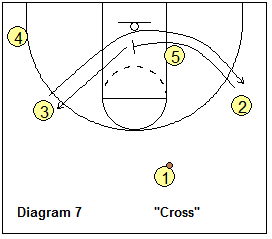
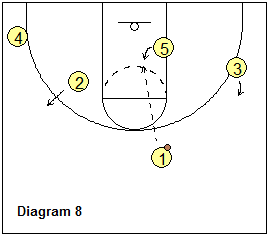
"Hold"
With hold, Hurley is trying to get a shot for a specific player - so he might call out "Hold for John", John being the player getting the shot. In diagram 9, we want to get a shot for O2. O2 cuts under O5, and then through the "elevator" screen set by O3 and O4.
As soon as O2 cuts through, O3 and O4 "close the door" on the screen, moving shoulder to shoulder. O1 passes to O2 for the shot. After screening, O3 cuts under O5 to the right wing as another option (diagram 10), and after O3 cuts through, O5 posts-up, and O1 might pass hi-lo to O5.
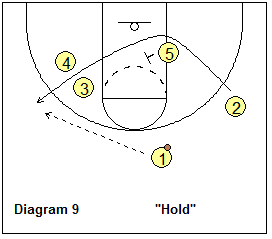
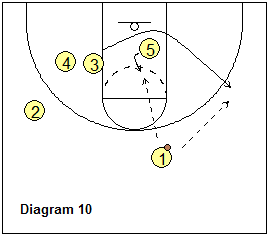
"Screen Away"
Hurley might use this to post up a perimeter player. In diagram 11, O1 passes to O2 and O1 cuts through to the opposite short corner, as O3 and O4 rotate up. O5 then screens-away for O1 (diagram 12), and O1 cuts to the ball-side block for the pass from O2. O5 flash cuts to the ball-side elbow and could get the pass from O2. O5 can then execute any of the "high-post options" (jump shot, shot fake and drive, pass to low post, pass to opposite wing).
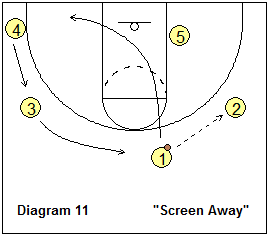
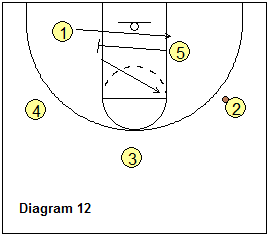
"High Ball-Screen"
Although not diagrammed here, the last audible is the high pick and roll option where the low post player O5 sets a high ball-screen for O1, and they run the pick and roll. An additional tip from Hurley: use your post player who is being guarded by the slowest, biggest post defender as your ball-screener. NBA teams have used this high ball-screen to get Shaquille O'Neal (on defense) away from the basket.
Formations
Coach Hurley uses four basic formations, or sets, to give his offense a different look - "Box", "2", "Hi-Lo", and "High". The audibles can be used with any of these formations.
"Box" formation
The "Box" formation is Hurley's main formation. Set up with post players O4 and O5 at the elbows and guards O3 and O2 on the blocks (diagram 18). O4 and O5 down-screen for O3 and O2 respectively, and the guards cut out to the wings.
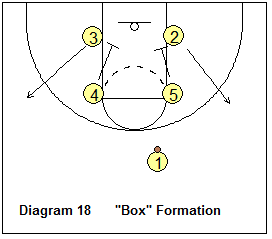
Box "Triangle" option
Coach Hurley presents his "Triangle" offense option, run from the Box formation (diagram 22). After passing to O2, O1 cuts to the ball-side corner, establishing the ball-side "triangle" (diagram 23). O4 flashes to the ball-side elbow. O2 could pass to O5, O4, O1, or skip-pass to O3. In diagram 24, O2 passes to O1 and cuts through, looking for the "give and go" pass back from O1. On the weakside, O3 and O4 set up a double, staggered screen for O2.
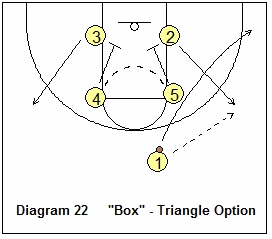
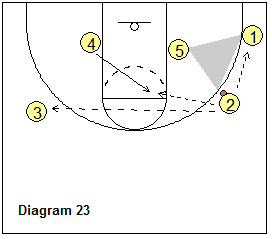
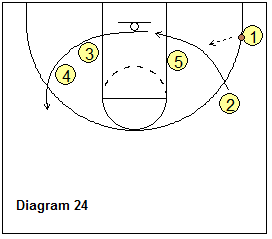
After O2 cuts through, O5 ball-screens for O1 (diagram 25). O1 dribbles around the screen for a possible jump-shot, or a pass to O2 coming around the staggered screens, or to O4 slipping the screen.
Let's back up... from the triangle, O2 passes to O4 at the high post (diagram 26). O4 now has all of the high post options available - shot, shot-fake/dribble drive, pass to the low post, and pass to the opposite wing.
If O4 passes to the opposite wing O3, he/she follows the pass and ball-screens for O3 (diagram 27).
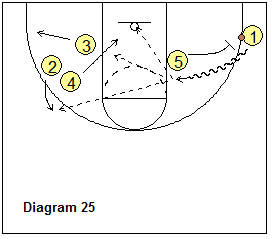
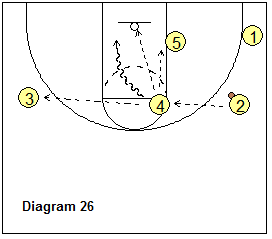
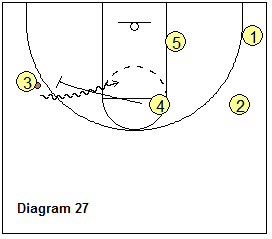
Ball reversal. Here O4 steps out on top and gets the pass from O2 (diagram 28), and O4 passes to O3. O5 cuts to the ball-side block to post up. O4 and O2 set a double, staggered screen for O1. O3 could shoot, pass to O5 in the post (diagram 29), or pass to O1 cutting around the double screen, or to O4 slipping the screen.
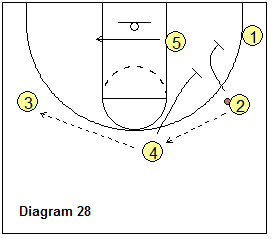
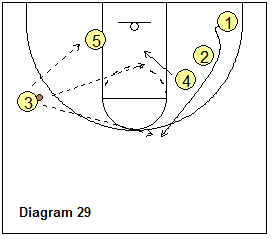
"2" formation
With this formation, start with a double low stack - "2" low stacks (diagram 32). You can run any of the audibles from this set. This gives us another look and might confuse the defense. O2 cuts out to the right wing. O3 either curls around O4's screen, or flares out to the corner or wing.
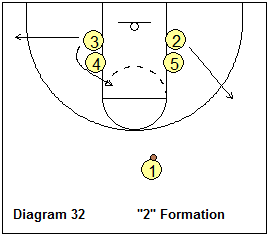
"Hi-Lo" formation
Here we start with a high ball-side double stack, with O5 and O2 at the right elbow area (diagram 35), and a weakside low double stack with O4 stacking above O3. O3 cuts out to the wing. O1 dribbles to the right wing, and once he/she reaches the free-throw line extended area, O5 cuts around O2 for a pass and lay-up. Hurley says he gets a lay-up with this about every other game, so look to run this as a special.
If the pass to O5 is not open, O1 passes to O2 on top. O5 posts-up looking for the hi-lo pass from O2. We can run any of the other audibles as well.
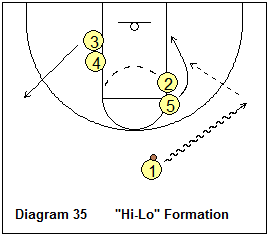
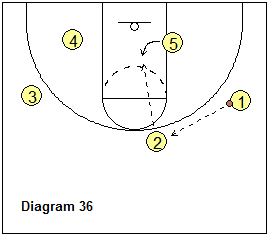
"High" formation
Here we start with two high double stacks, with O5 and O2 at the right elbow area (diagram 37), and O4 and O3 at the left elbow. O2 and O3 cut to the wings, and we are now in a 1-4 high set (diagram 38).
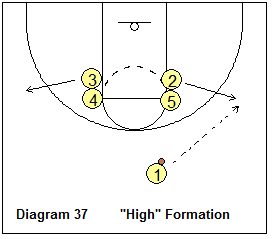
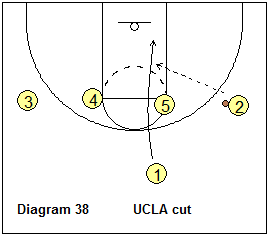
In Summary...
There is a lot of great stuff on this DVD. Although beyond the scope of this article, Coach Hurley also discusses his motion principles, and how to use this offense for attacking zone defenses. Transition offense is presented. More information on high post and wing options, and other basic motion actions are included. A section on his "Wheel" offense is included.
He also shows how to attack full-court pressure when your point guard is being denied the inbounds pass. I highly recommend this DVD for learning more about motion offense. Coach Hurley's track record speaks for itself - Coach Gels.
See the complete article in the members section. The complete article also includes:
- Transition: getting into the offense
- High post options
- Wing options
- Triangle Shuffle cut
- "Wheel" Offense
- More Motion Options - Actions
- Dribble-at/Back-cut
- Dribble-at/Button-hook
- "Bump" Post Defender
- "Bump" Perimeter Defender
- Reversal
- Attacking Full-Court Pressure
Source: https://www.coachesclipboard.net/HurleyMotionOffense.html
0 Response to "Continuous Motion Offense Screen Away Continuity"
Post a Comment